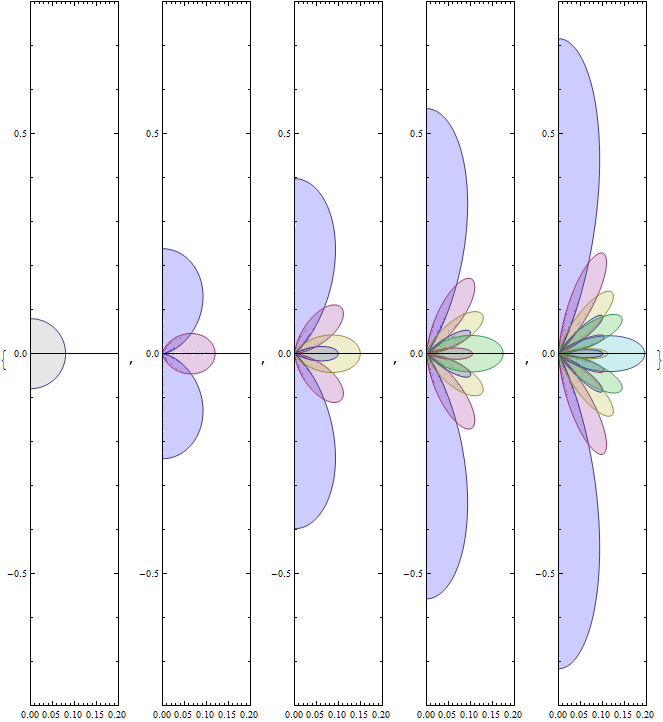量子力学Ⅰ/球面調和関数 のバックアップ(No.3)
更新- バックアップ一覧
- 差分 を表示
- 現在との差分 を表示
- ソース を表示
- 量子力学Ⅰ/球面調和関数 へ行く。
球関数 $Y^m_l(\theta,\phi)$:角運動量の固有関数 †
回転方向の方程式に を掛けると、 であるから、
&math(
- \hbar^2\hat\Lambda Y(\theta,\phi)=\hat{\bm l^2}Y(\theta,\phi)=\underbrace{\hbar^2l(l+1)}_{固有値}Y(\theta,\phi) );
となって、これはそのまま全角運動量の固有値問題になっていることが分かる。
つまり、時間に依らないシュレーディンガー方程式を変数分離して得られた固有関数は、 同時に全角運動量の固有関数でもある。
具体的に方程式を書き下せば、
&math( \Big[\frac{1}{\sin\theta} \frac{\PD}{\PD \theta} \Big(\sin\theta\frac{\PD}{\PD \theta}\Big)+\frac{1}{\sin^2\theta} \frac{\PD^2}{\PD \phi^2}\Big]Y(\theta,\phi)=-l(l+1)Y(\theta,\phi) );
これをさらに変数分離するため、 を代入すれば、
&math( &\Big[\sin\theta \frac{\PD}{\PD \theta} \Big(\sin\theta\frac{\PD}{\PD \theta}\Big)+\frac{\PD^2}{\PD \phi^2}\Big]Y(\theta,\phi)=-l(l+1)\sin^2\theta Y(\theta,\phi)\\ );
&math( &\frac{1}{\Theta(\theta)}\Big[\sin\theta \frac{\PD}{\PD \theta} \Big(\sin\theta\frac{\PD}{\PD \theta}\Big)+l(l+1)\sin^2\theta\Big]\Theta(\theta)=-\frac{1}{\Phi(\phi)}\frac{\PD^2}{\PD \phi^2}\Phi(\phi)\\ );
共通の定数を後を見越して と置くと、 に関する方程式は
となり、
一方、 の方程式
&math(\Big[\sin\theta \frac{\PD}{\PD \theta} \Big(\sin\theta\frac{\PD}{\PD \theta}\Big)+l(l+1) \sin^2\theta\Big]\Theta(\theta)=m^2\Theta(\theta));
は、 が
の範囲の整数になるときのみ解を持ち、その固有関数はルジャンドルの陪関数を用いて表わすことができる。
ただし、 はルジャンドルの多項式で、
によって与えられる。これらを用いた
は規格直交完全な固有関数となり、この関数を 球面調和関数 と呼ぶ。
|
・・・ |
特徴 †
- より、 &math((-1)^{(m-|m|)/2}=\begin{cases}
- 1\hspace{0.5cm}&m>0\ または\ m\,が偶数\\
- 1&m<0\ かつ\ m\,が奇数 \end{cases});
- と の 次同次関数になっている ( などとなることに注意せよ)
- すなわち、全角運動量は である
- すなわち、 軸周りの角運動量は である
形状 †
方向別に の大きさをプロットした。
- 方向は位相が回転するだけで大きさは変化しない
- と は位相のみが異なり、同じ形になる
- は球形
- ( )は原点に節を持ち 方向に長く、 原点周りに 枚のひだを持つ。 が大きいほど 方向への伸びが長くなる。
- ( ) は 方向には値を持たず、 軸を取り囲むように 枚のひだを持つ。
- はドーナツ型になる。 が大きいほど扁平で、半径も大きい。
File not found: "Y0-0.jpg" at page "量子力学Ⅰ/中心力場内の粒子"[添付]
File not found: "Y1-0.jpg" at page "量子力学Ⅰ/中心力場内の粒子"[添付] File not found: "Y1-1.jpg" at page "量子力学Ⅰ/中心力場内の粒子"[添付]
File not found: "Y2-0.jpg" at page "量子力学Ⅰ/中心力場内の粒子"[添付] File not found: "Y2-1.jpg" at page "量子力学Ⅰ/中心力場内の粒子"[添付] File not found: "Y2-2.jpg" at page "量子力学Ⅰ/中心力場内の粒子"[添付]
File not found: "Y3-0.jpg" at page "量子力学Ⅰ/中心力場内の粒子"[添付] File not found: "Y3-1.jpg" at page "量子力学Ⅰ/中心力場内の粒子"[添付] File not found: "Y3-2.jpg" at page "量子力学Ⅰ/中心力場内の粒子"[添付] File not found: "Y3-3.jpg" at page "量子力学Ⅰ/中心力場内の粒子"[添付]
File not found: "Y4-0.jpg" at page "量子力学Ⅰ/中心力場内の粒子"[添付] File not found: "Y4-1.jpg" at page "量子力学Ⅰ/中心力場内の粒子"[添付] File not found: "Y4-2.jpg" at page "量子力学Ⅰ/中心力場内の粒子"[添付] File not found: "Y4-3.jpg" at page "量子力学Ⅰ/中心力場内の粒子"[添付] File not found: "Y4-4.jpg" at page "量子力学Ⅰ/中心力場内の粒子"[添付]
$z$ が特殊なわけではない †
上のグラフを見るとあたかも が特殊な方向であるかのように錯覚するがそんなことはない。
や、
は、 とそっくり同じ形で、それぞれ 方向を向いた関数となる。
File not found: "Y1-0z.jpg" at page "量子力学Ⅰ/中心力場内の粒子"[添付] File not found: "Y1-0x.jpg" at page "量子力学Ⅰ/中心力場内の粒子"[添付] File not found: "Y1-0y.jpg" at page "量子力学Ⅰ/中心力場内の粒子"[添付]
同じ量子数 に属する、縮退した 個の固有関数からなる任意の線形結合は すべて同じ固有値に属する固有関数となる。その中で特に の固有関数でもある物を と名付けたに過ぎない。
の固有関数であるように選んだのだから が特殊な軸になっているというだけ。
すなわち、球対称な定数関数となる。下図は の場合。
File not found: "Y1-0all.jpg" at page "量子力学Ⅰ/中心力場内の粒子"[添付]
